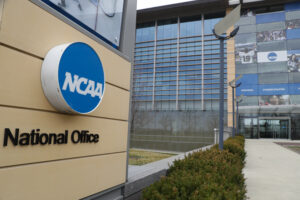As colleges and universities prepare to legally pay athletes for the first time in National Collegiate Athletic Association history, collegiate sports programs are exploring insurance policies designed to mitigate the risks that come with dishing out tens of millions of dollars annually to players.
A proposed settlement deal between the NCAA and five major collegiate sports conferences is expected to soon allow schools to directly compensate students for the first time in 119 years of organized competition. Total pay will be capped at about $20 million per school.
“The reason why insurance is now being introduced more consistently is that there are now real dollars at risk,” said Tyrre Burks, founder and CEO of Players Health, a sports-centric managing general agency. “And we’re not talking a small amount of dollars, either. We’re talking billions of dollars that are now going to athletes. Universities, for the first time, are now sharing athletic department revenues back to the athletes.”
Burks said Players Health gives clients greater visibility of their risks while supplying them with tools and resources to mitigate them. One of those resources is insurance; the Minneapolis-based company writes general liability, equipment and property, D&O and more lines of coverage for youth, amateur and collegiate sports organizations.

Following decades of a strict no-pay policy enforced by the NCAA, athletes were cleared to begin profiting off their name, image and likeness (NIL) in 2021. They have since been legally allowed to receive money from third parties like donor collectives and brand sponsorship deals — but they haven’t been cleared to receive funds directly from their schools.
That stands to change soon. Sports Illustrated reported May 24 that many in the college football world expected a decision to come last week in the landmark House vs. NCAA settlement, but as of press time, approval had not yet been announced.
In the meantime, Players Health has developed and begun selling policies that aim to address the risks that schools will face under the new payment system. Because while the NCAA has long pulled from a pool of carriers to provide participant accident policies for collegiate athletes, that health insurance only covers medical costs to athletes.
The critical injury insurance policy offered by Players Health is designed to insure payment from a school or collective to a student athlete should that athlete suffer an injury that forces them to miss at least 40% of a sports season. The product is parametric; pre-determined injuries are covered, and if the insured athlete suffers one of them and meets the 40% threshold, the policy triggers.
“It’s a very flexible product for these universities,” Burks said. “They can protect their downside, and we’ll insure up to a million dollars with that product.”
Related: Colorado Secures Record Insurance Coverage for Stars Playing in Bowl Game
Players Health calculates an injury probability for every athlete to determine policy premiums. Burks said his company has aggregated one of the largest injury databases in amateur sports and uses that data to create the predictive model.
The MGA also offers a contract protection product that insures against player transferring. When the NCAA’s transfer portal system launched in 2018, it made it easier than ever for athletes to switch schools. In the current sports calendar, Burks said that front-loading cash to players who want upfront payments has its pitfalls.
An athlete could sign a deal with a school when the first open transfer portal period begins in December, Burks said, and then transfer away in the spring — when the second portal period begins — without ever playing a game for the school that paid them.
“You could insure the transfer risk that you have for that athlete,” Burks said, explaining that Players Health has created a model that predicts the likelihood an athlete will transfer and bakes that into the premium. This policy is designed to help keep predatory language out of contracts, Burks said, while also preventing litigation and making schools whole.
In addition to critical injury and contract protection, Players Health offers schools a fair market value bonus product that Burks said allows schools to punch above their weight when it comes to attracting and retaining athletes.
Colleges and universities aren’t allowed to award performance bonuses directly to players, but Burks explained that through these policies, payment triggers to a school if an athlete hits on-the-field milestones that increase their value, like being named to an all-conference team or winning the Heisman trophy.
“Ultimately, the athlete now has these triggers that they can shoot for,” Burks said. “They know their value is worth more, and … they’ve got an extra half a million dollars that they can go and achieve if they hit these milestones. Now, they’re worth more in the market.”
Schools from the Big 12, SEC and Big East conferences have purchased policies outlined in this piece from Players Health. Burks said the MGA’s focus is to democratize data and use insights to drive changes in behavior and decision-making.
“We’re not trying to just push papers and just send over a policy,” he added. “We want the client to understand why they’re buying it, and we want them to be just as educated about why they’re buying it and the product as we are.”
Topics K-12
Was this article valuable?
Here are more articles you may enjoy.



 Aon Adds to List of Brokers Suing Howden US for Alleged Poaching, Theft
Aon Adds to List of Brokers Suing Howden US for Alleged Poaching, Theft  Senators Launch Probe Into Demotech’s Ratings in Florida
Senators Launch Probe Into Demotech’s Ratings in Florida  North Carolina Sting Operation Alleges Roofer Damaged Shingles to File Claim
North Carolina Sting Operation Alleges Roofer Damaged Shingles to File Claim  Twice Injured Firefighter Loses Second Workers’ Compensation Claim
Twice Injured Firefighter Loses Second Workers’ Compensation Claim 

